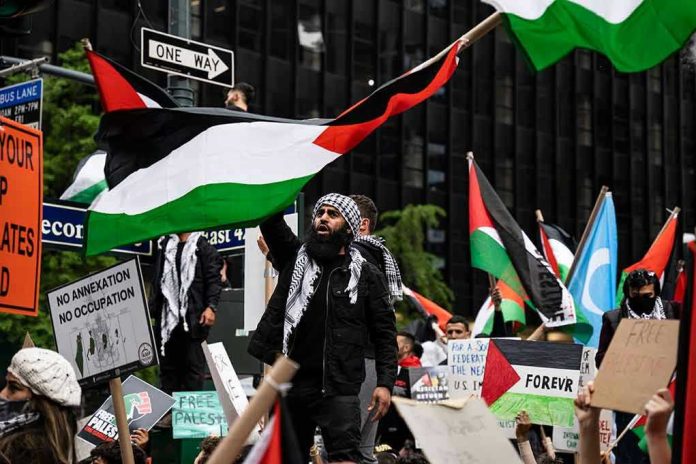
On the anniversary of an attack that transformed Middle East politics, student protests on campuses worldwide have become the new front line in a generational struggle over war, justice, and the power of youth movements to shape global discourse.
Story Snapshot
- Hundreds of students organized pro-Palestinian rallies on the anniversary of Hamas’ deadly October 7, 2023 attack on Israel.
- These demonstrations signal a surge in youth activism and changing attitudes on the Israeli-Palestinian conflict within academia.
- The rallies reflect deepening polarization and renewed debate over free speech, humanitarian crises, and university policies.
- Wider public opinion and institutional responses are being tested by the scale and intensity of these protests.
Anniversary Sparks a New Wave of Campus Activism
October 7 has become more than a date—it is a rallying cry. On its first and second anniversaries, hundreds of students at universities from North America to Europe and Australia took to the quads and city squares, wielding banners and megaphones. Their message: demand a ceasefire in Gaza, protest Israeli military operations, and call attention to the humanitarian crisis that has gripped the region since Hamas launched its attack in 2023. The spectacle of young people, often dismissed as politically apathetic, transformed campuses into stages for the world to witness contentious, impassioned demands for justice and accountability.
Rallies were meticulously timed to coincide with the anniversary of the Hamas assault, giving them both symbolic and strategic power. For many students, the ongoing war in Gaza—marked by repeated Israeli operations, high civilian casualties, and a mounting humanitarian catastrophe—has become intolerable. They see their activism as a moral imperative, even as it places them at odds with powerful interests on and off campus. University administrators, meanwhile, struggle to maintain order and navigate the treacherous waters of free expression, donor influence, and public scrutiny.
From Historical Grievance to Modern Mobilization
The roots of these protests are deep. The Israeli-Palestinian conflict stretches back to the early 20th century, with each generation inheriting layers of tragedy and grievance. But what distinguishes the current wave is a convergence of technology, global interconnectedness, and the raw visibility of suffering in Gaza. Student organizers draw on decades of protest tradition, yet their tools—viral social media campaigns, real-time video, and decentralized organizing—make the rallies larger, more coordinated, and harder to ignore. Each chant and march is amplified far beyond the campus gates.
Student activism itself is evolving. The calls for divestment, institutional statements, and academic boycotts echo tactics seen in past movements, from anti-apartheid to climate justice campaigns. Yet the emotional charge is heightened by graphic images and narratives from Gaza, fueling a sense of urgency and outrage. These protests are not isolated; they are part of a global conversation, drawing in participants from diverse backgrounds, including those with little direct connection to the region itself.
The Campus as a Battleground for Ideas and Policy
Universities find themselves caught in a crossfire. On one side, students and faculty demand unequivocal support for Palestinian rights and humanitarian relief. On the other, critics warn that some protests cross the line into antisemitism or threaten campus order. Administrators issue carefully worded statements, affirming free speech while condemning hate speech and violence. The balancing act is fraught, as leaders face pressure from donors, alumni, and political figures. Each new protest tests the boundaries of academic freedom and institutional neutrality.
The debates are not merely academic. Calls for divestment from companies linked to Israel have economic implications, potentially affecting university endowments and donor relations. Media coverage of protest disruptions and police responses adds another layer of complexity. For many involved, these moments are formative—shaping political identities and, perhaps, the future direction of public policy. The ripple effects extend well beyond campus, influencing broader debates on foreign policy and human rights.
A Movement with Uncertain Outcomes
The impact of these rallies remains uncertain, but the stakes are high. In the short term, campus tensions have escalated, with some universities experiencing disruptions, threats, or even physical confrontations. In the long term, the protests could drive institutional changes, from divestment policies to new frameworks for handling dissent. They may also contribute to shifting public opinion, especially as younger generations become more vocal and visible in their advocacy for Palestinian rights.
Expert observers caution against simplistic narratives. While some celebrate the protests as vital expressions of democratic engagement, others warn of the dangers of polarization and the potential for harmful rhetoric. The Israeli-Palestinian conflict is a labyrinth of history and emotion, and student activism is both a mirror and a catalyst for society’s deepest divisions. As the war in Gaza grinds on, the campuses remain a microcosm of the world’s struggle to reconcile justice, security, and humanitarian values. Whether these rallies will ultimately drive political change or deepen the divides is an open—and urgent—question.
Sources:
Sky News – Timeline of events in the year since 7 October
Wikipedia – Timeline of the Gaza war
CFR – Israeli-Palestinian Conflict Timeline









